- Experimental Investigation on Room Temperature Vulcanised Silicone rubber and Epoxy resin coated porcelain outdoor insulators located at highly polluted environment
M. Ravindrana,*, S. Senthil Kumarb, N. Karuppiahc and M. Asokand
aAssociate Professor (S.G), Department of EEE, National Engineering College, Tamil Nadu, India
bAssistant Professor (S.G.), Department of EEE, National Engineering College, Tamil Nadu, India
cProfessor, Department of EEE, Vardhaman College of Engineering, Telangana, India
dPG Scholar, National Engineering College, Tamilnadu, India
Insulators flashover is one of
the major problem that confronts all around the world, particularly in austere
weather conditions and highly polluted areas. Any failure in the acceptable
performance of high voltage insulators result in intrerruption of electrical
power that leads to loss of capital. Flashover voltage (FOV) is directly
related to the severity of pollution on the surface of insulator. Generally,
anti-pollution flashover coating is considered as one of the most effective
means to prevent and reduce flashover. This paper investigates and compares the
results on application of Epoxy Resin and Room Temperature Vulcanized (RTV)
Silicone Rubber for improving the performance of outdoor (near coastal thermal
plant area) insulators of 12 KV rating. The flash over voltage of the
insulators is optimized for a polluted environment by applying the protective
coating and tested experimentally. The experimental results are compared with
simulated results using Artificial Neural Network.
Keywords: Artificial Neural Network, Epoxy Resin, Flashover voltage, Post Type Insulator
The rapid development of modern society and industries,
worldwide, made the power requirement to be more significant. The reliability
of the electrical network and its setup is essential for the satisfactory performance
of an electric power system [1, 2]. Insulators are one
among the significant apparatus in the high voltage transmission line and
switch yard, which are used for keeping apart the electrical
supply irregularities [3].
In general, electric power system has exploited the usage
of ceramic and non-ceramic insulators. In recently developed
transmission systems, polymer insulators which offer
several advantages over porcelain insulators are
used. Polymer insulators have excellent hydrophobic surface
property under wet conditions, eminent mechanical strength to
weight ratio, saving on labour due to less weight and bringing down maintenance
costs [4, 5]. Eventhough, polymer insulators have a number of advantages, it
suffers from a significant drawback i.e, these insulators are more prone to
chemical changes (weak bond compared to porcelain). Also, it suffers from
erosion and tracking their life expectancy is difficult. Porcelain Insulators
have some advantages over the polymer insulators as it is environmental
friendly, higher electrical strength (25 kV/mm), high thermal resistance,
stable against the effects of UV radiation and do not suffer
from defects in the ceramics-to-metal interface. Porcelain is a
sluggish and stable material and the surface does not easily degrade,
because dry band arcing withstand capacity is
high when compared to silicone rubber [6-8].
Pollution is a million dollar problem especially for
outdoor insulation systems. Pollution severity and the contamination present on
the surface of the insulators depend on the type of surface area of the
insulator (marine, industrial, ice and fog, chemical, desert, bird segregation
etc). There are several factors that are responsible for the flashover voltage
on the surface of the insulator [9]. They are surface resistance of a
material, surface condition and electric field intensity within the
conductor and insulator. Electric Arcing is an outside disruption on the
insulator surface. It is a cognitive process whose value is smaller
than the puncture voltage of the insulator. Sometimes it
exceeds the ceiling value and damages the insulator due to puncture which is
one of the worst cases that must be avoided. This paper investigates a 12 kV
Post type ceramic insulator which has been taken from near coastal coal based
power plant, which is situated in a nearest coastline within 1 km. The
combustion of coal at thermal power plants lets out carbon dioxide (CO2),
sulphur oxides (SOx), nitrogen oxides (NOx), CFCs particulates such as fly ash
and Suspended Particulate Matter (SPM) ranging from 0.5 to
100 micron in size. Because of these pollutants electrical
equipments of coal based power plant are extremely
affected [10, 11]. These coastal insulators often comes into
contact with dust and humidity (seashore area) and
thereby gets affected by the problem of corona. Generally
anti-pollution flashover coating is considered to be one of the most effective
means to prevent and reduce pollution flashover.The thickness of coating should
also be improved to withstand the voltage of the insulator. Silicone oil and
silicone grease are some of the existing coating methods that increases the
life of the insulator. Protective polymer coatings greatly bring down
the frequency of cleaning of insulators and periodic
re-application of greases besides their drawbacks such as poor mechanical
strength, thixotropic performance, tracking, erosion performance and flame
retardancy [12, 13].
In literature discussed above,
the strength of protective polymer
coating of Epoxy Resin and Silicon rubber are compared. In recent literatures,
the need for an optimization technique to
improve the new design of insulator is discussed [14-16]. COMSOL is one of the
advanced Finite Element methods and multi physics software package used to find
out the optimized effect of electric field
distribution of insulators. It is also used to minimize the electrical stress at the vicinity of the insulators [17, 18]. Also MATLAB is used in
simulation and mathematical modelling
of insulators. Critical flash over
voltages of insulators are obtained through MATLAB simulation and these simulated values are
compared with the experimental values.
Post
insulator specimens
Two test specimen sets (12 kV Post Type Ceramic Insulator)
which are predominently used in high and extra high voltage substation switch
yards are taken. These specimen insulators are used for supporting electrical
equipment and bus conductors in switch yards. It is different from pin
insulator in such a way that it has metal support on both sides. Firstly, the
test specimens are measured in dimensions to find out the Insulation resistance
values. These measured values for the test specimens are shown in Table 1. In
this test, the insulators are cleaned and the measurement of
breakdown voltages and leakage current are
noted without pollution. The flasover voltages of the
specimen insulators are tested experimentally and these values are shown in
Table 2. Flash overvoltage test on insulator specimens should be
conducted only a few times orelse the insulator may destroy
permanently. The Insulator specimens should also be strong enough
to withstand over voltages during the operation.
Experimental setup
Fig. 1 shows the experimental setup in high voltage laboratory.
The setup has coupling capacitance and high voltage
transformer. The voltage rating of transformer is 2×0.22/100/0.22 kV, current
rating is 2×22.8/0.1A, with output rating as 10 kVA. The high voltage lab comprises of control panel with exact metering
facilities.
Pollution test without protective coating
Before conducting the tests on the insulators, they are
scavenged to get rid of dirt and greases. The type of pollutants which are
accumulated near coastal thermal plants are coal and fly ash. These are taken
at different ratios, and then mixed with distilled water and enforced over the
surface of the insulators test specimens by brushing method. The artificial
tests are carried out in high voltage laboratory and the test specimens are put
on slowly from zero voltage until consummate flashover
falls (occurring flashover as shown in Fig. 2) out on the insulator surface.
The average flashover voltage and leakage current is precipitated when the
quantity of dust is aroused. At flashover, the voltage and leakage current is
put down.
Pollution test with protective coating
To improve the performance of porcelain insulator under
polluted conditions, coatings are used to extenuate surface
leakage current, surface discharge and bring down flashover occurrence. This
practice is particularly desirable for insulators established at substations
with pollution severity. This analysis looks into the
performance of the proposed protective coating which increases the
property of leakage current suppression and flashover voltage performance of
the insulators in comparison with Epoxy Resin coatings and silicone rubber
(RTV) coatings.The epoxy
group, which is also addressed as the
glycidyl group, has higher molecular group to commute Epoxy resin to plastic
and this setting is called as a hardener. The hardener for the epoxy resins are
primarily diamines and polyamines and chemical compounds with various molecular weights. These have high
mechanical strength, chemical resistance, diffusion density, water tightness, electrical insulation capacity, shrinkage, Heat resistance etc., Silicone
rubber compounds have characteristics of both inorganic and organic
materials. Si-COAT 570 HVIC (High voltage
Insulator Coating) is a one-part; room temperature vulcanizing (RTV)
polysiloxane (silicone) coating. Its unique con- ceptualization furnishes a highly
hydrophobic surface for its entire life. The coating is not impacted by UV
light, corona discharge, chemical contaminants, salt, extreme temperatures or
corrosive environments. Fig. 3 represents the structure of a RTV silicone
rubber [19].
Coating the porcelain post type insulators with RTV
coating is the only way to improve the water repellence of the surface. The
coating is enforced on the insulator surface by spraying the liquid polymer,
which then vulcanizes in presence of air into a flexible plastic layer and
Epoxy Resin coating applied by brushing method as shown in Fig. 4.
Flashover voltage vs Non Soluble Deposit Density value
(NSDD) are compared for the test specimens without pollution test (dry and wet
condition) and pollution test with RTV and Epoxy Resin coated 12 kV insulator
through high voltage testing. Fig. 5 represents graphically the flash over
voltage of insulator test specimens without pollution test and with pollution
test coated with different resins (Epoxy Resin and RTV).
Fig. 6 represents the comparison of fly ash pollutants
with Epoxy Resin and RTV coating and without flyash pollutant. Tests are
conducted and flash over voltage is obtained in each case. In both the graphs
referred, it is clear that when the NSDD values are increased for every ratio
the flashover voltage has decreased. In wet conditions the flashover is
atrociously departed along with the increase of pollution
severity. In dry conditions the flash over voltage has slight
variations. In dry flash over, the performance comparison between epoxy resin
and silicone rubber are same, but in wet conditions silicone rubber coating has
better performance when compared to epoxy resin. Fig. 7
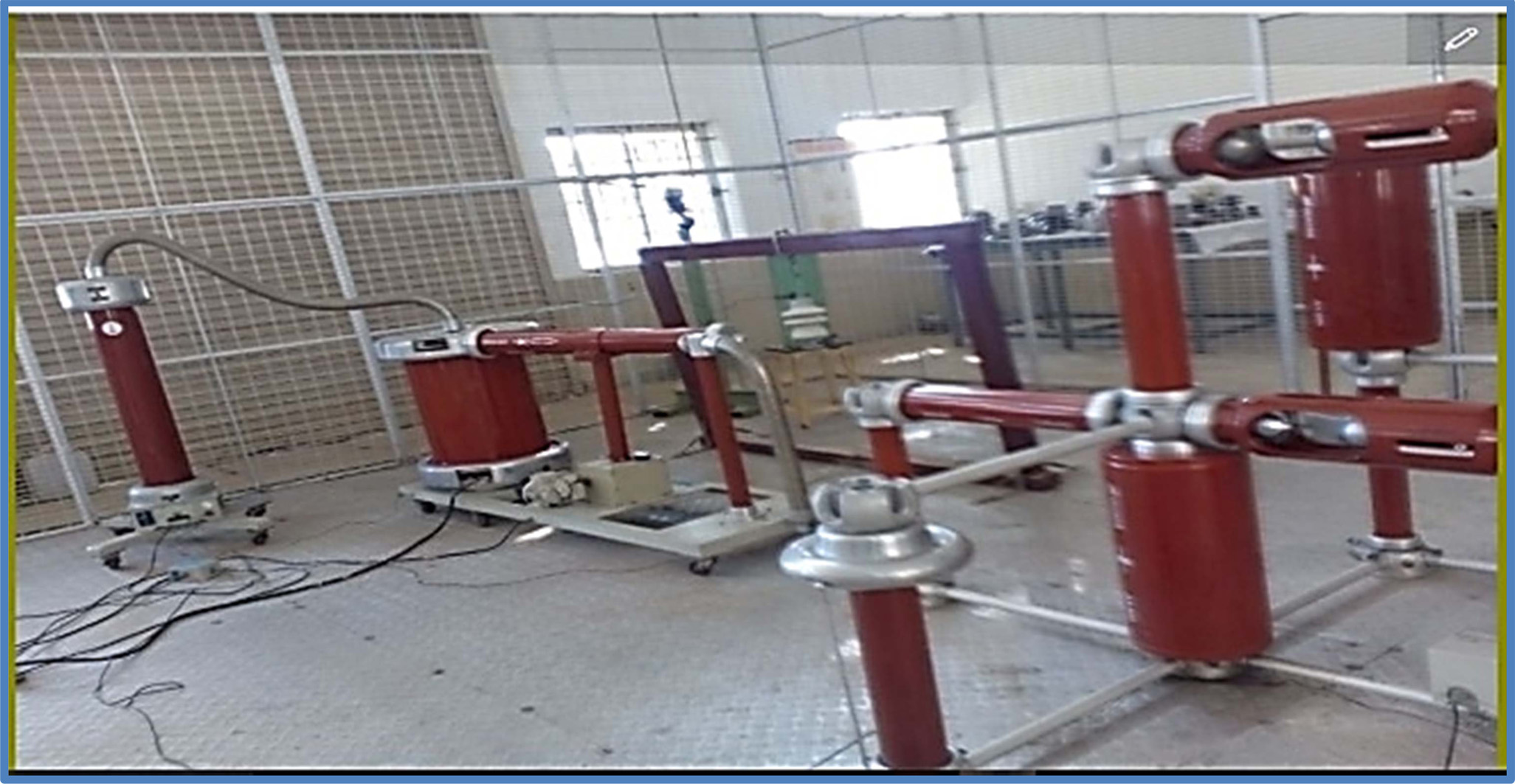
|
Fig. 1 Experimental set up at High Voltage Research Laboratory in National Engineering College, Kovilpatti, Tamilnadu. |
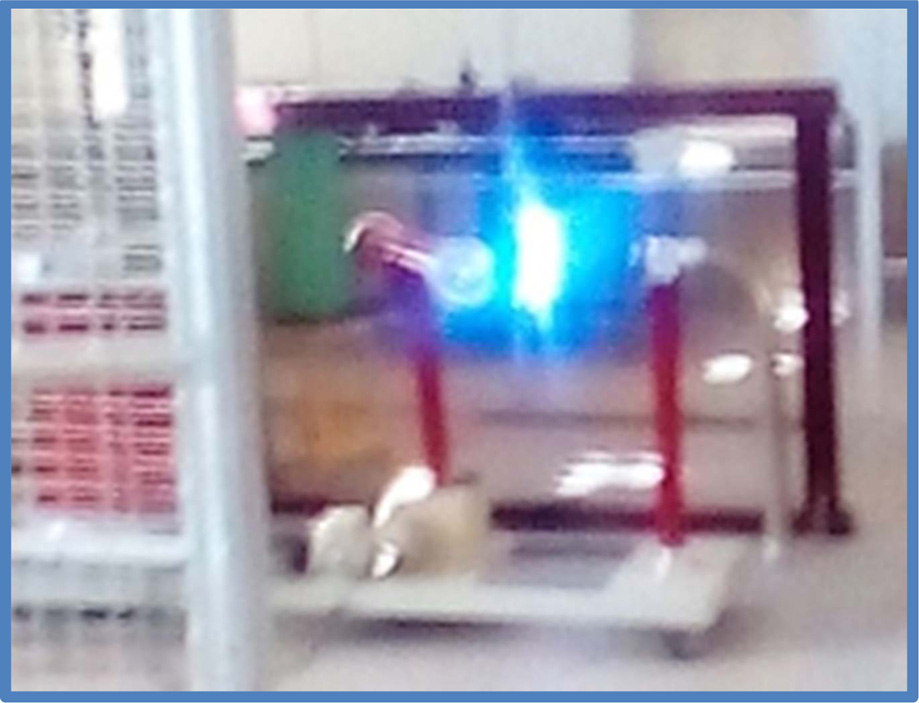
|
Fig. 2 Occurrence of flashover in Insulator test specimens |
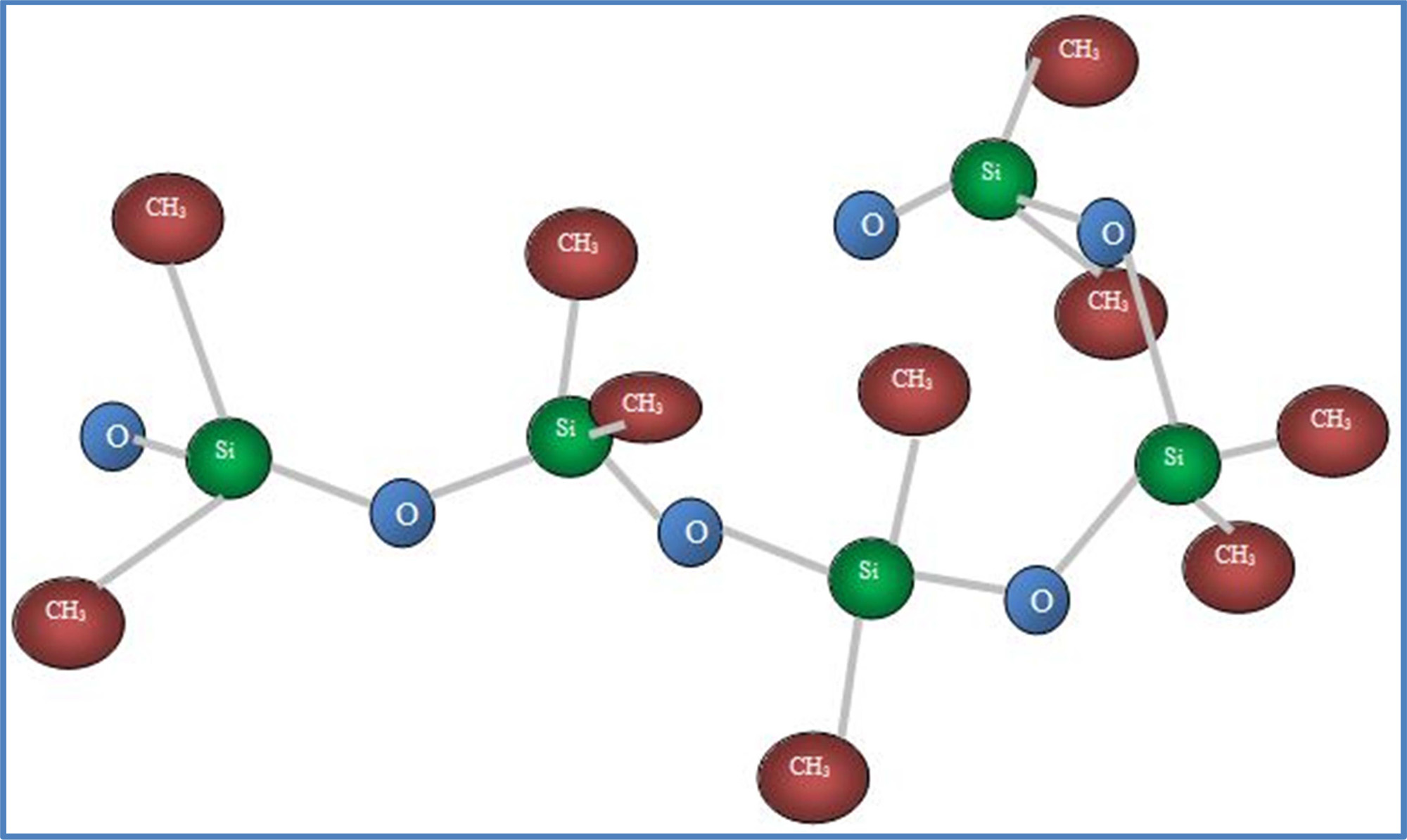
|
Fig. 3 Chemical structure of a linear silicon polymer |
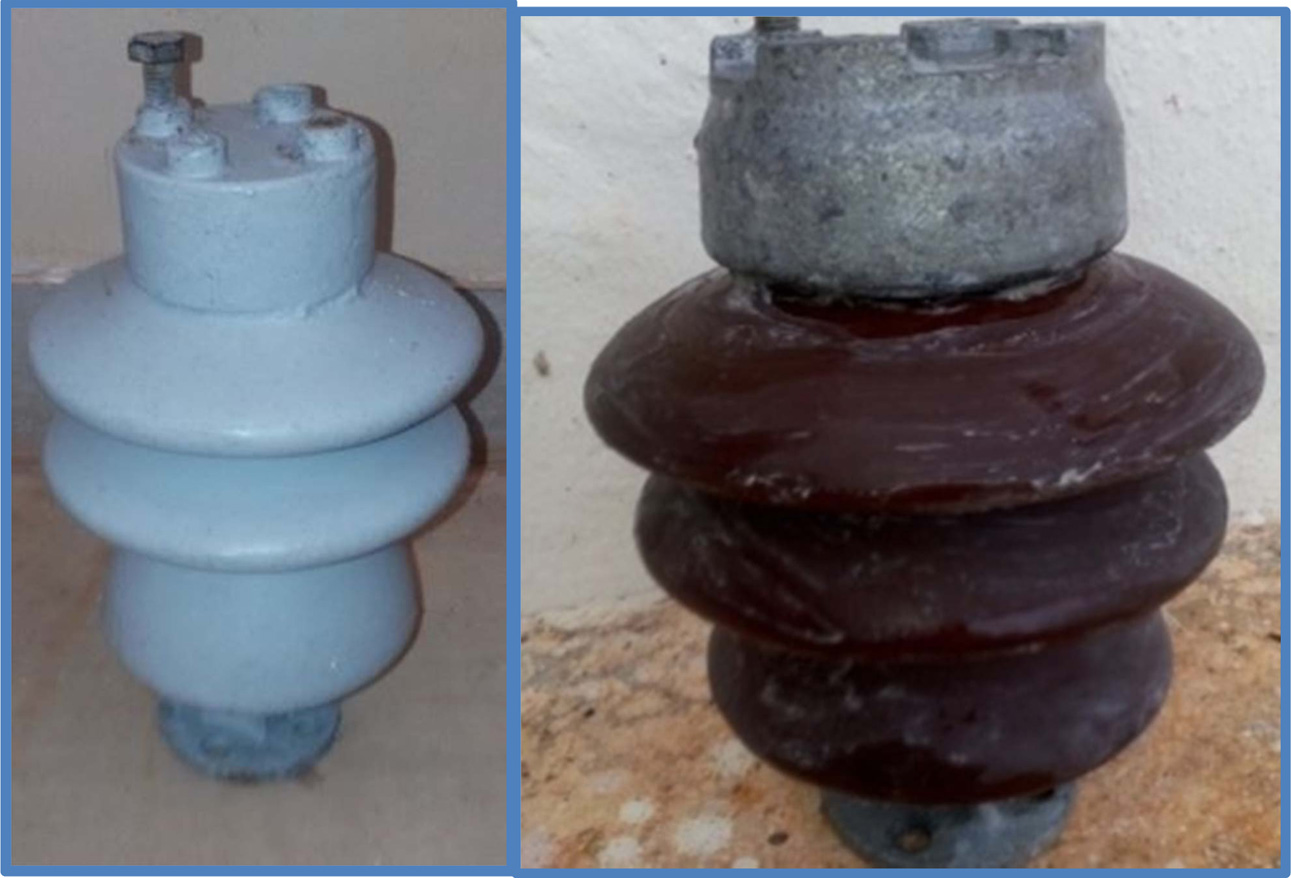
|
Fig. 4 RTV Silicone and Epoxy Resin Coating. |
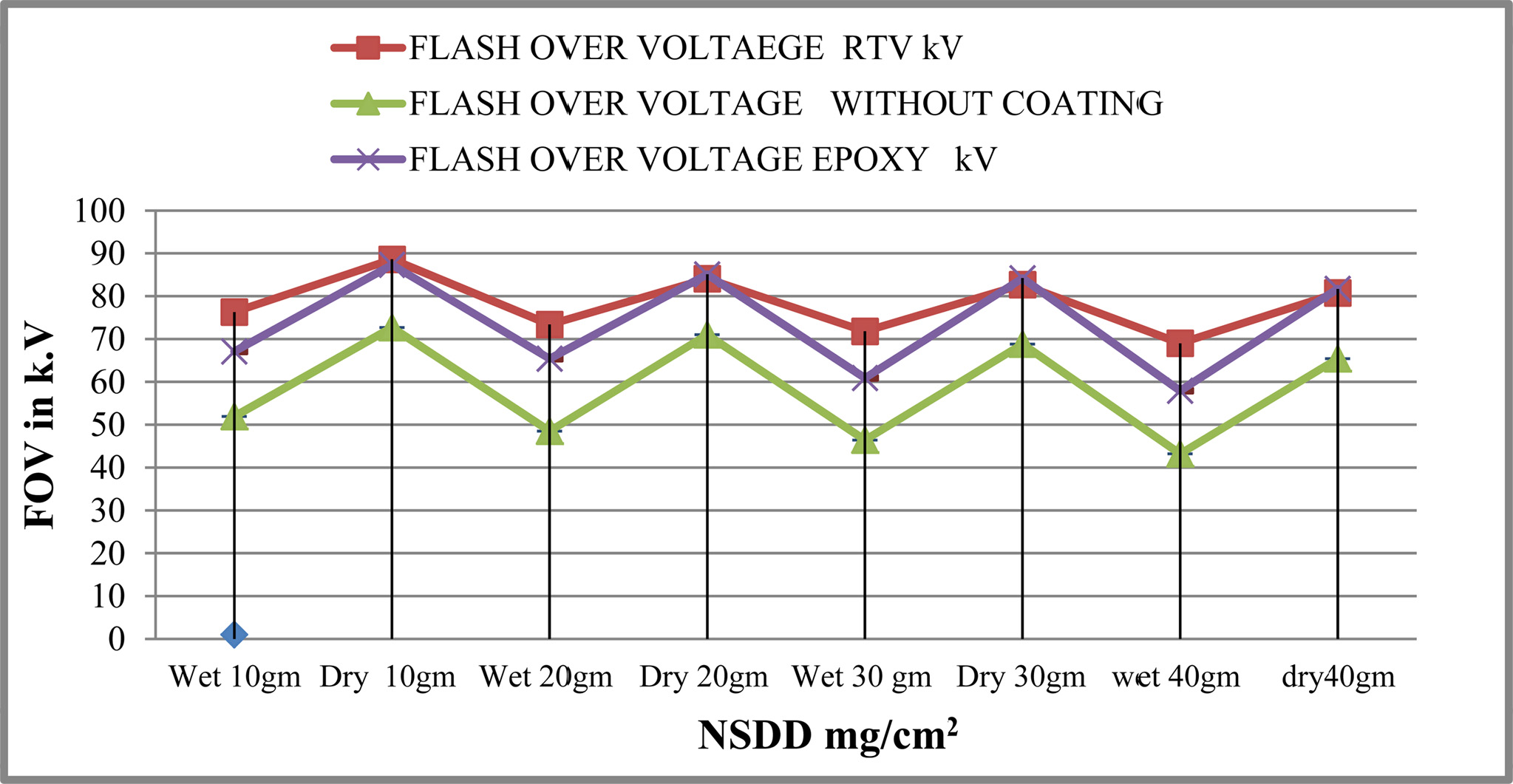
|
Fig. 5 Comparison of flash over voltages of insulator test specimens with Epoxy Resin and RTV Coating with coal pollutant and without pollutant test. |
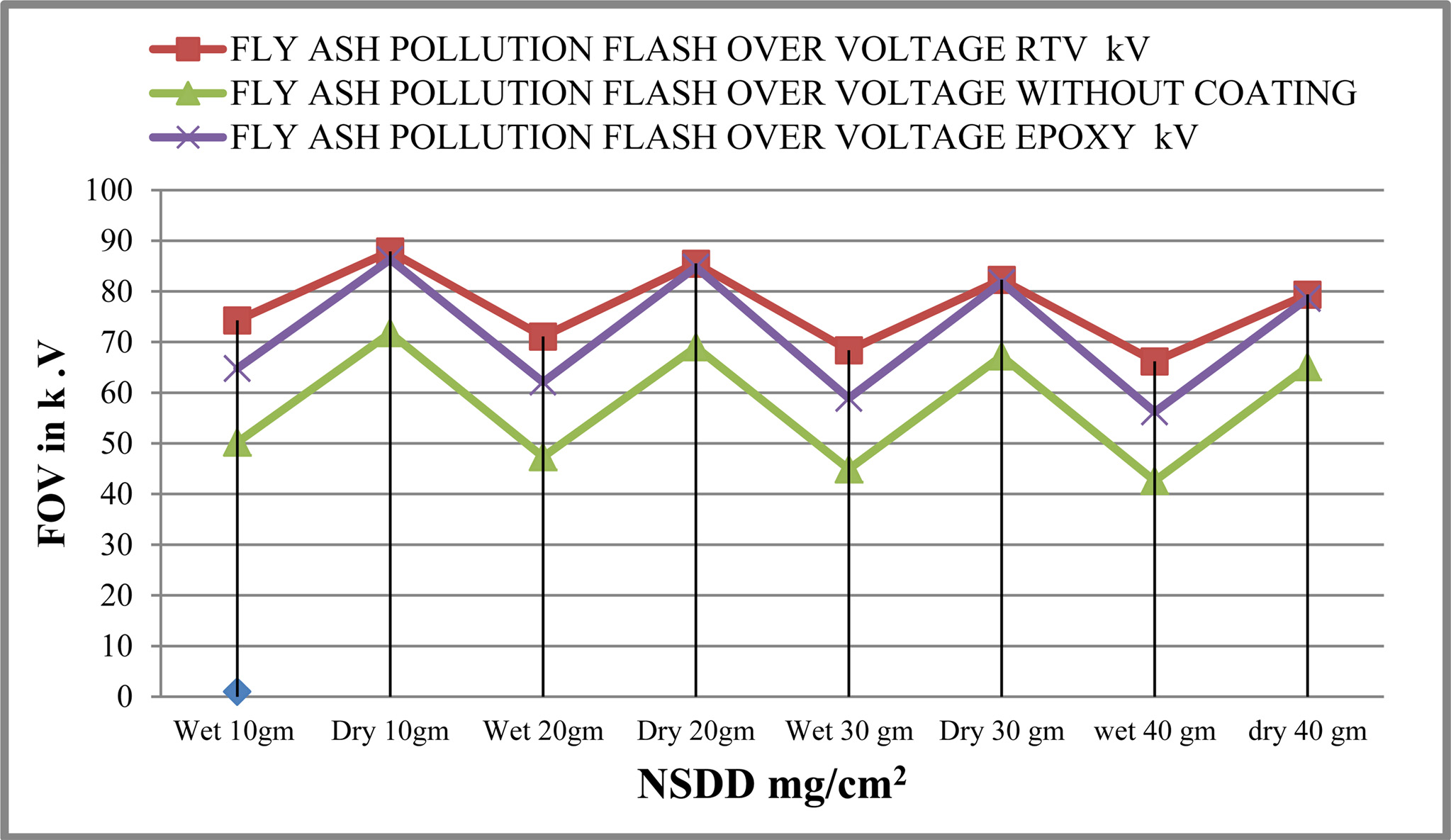
|
Fig. 6 Comparison of flash over voltages of insulator test specimens with Epoxy Resin and RTV Coating with fly ash pollutant and without pollutant test. |
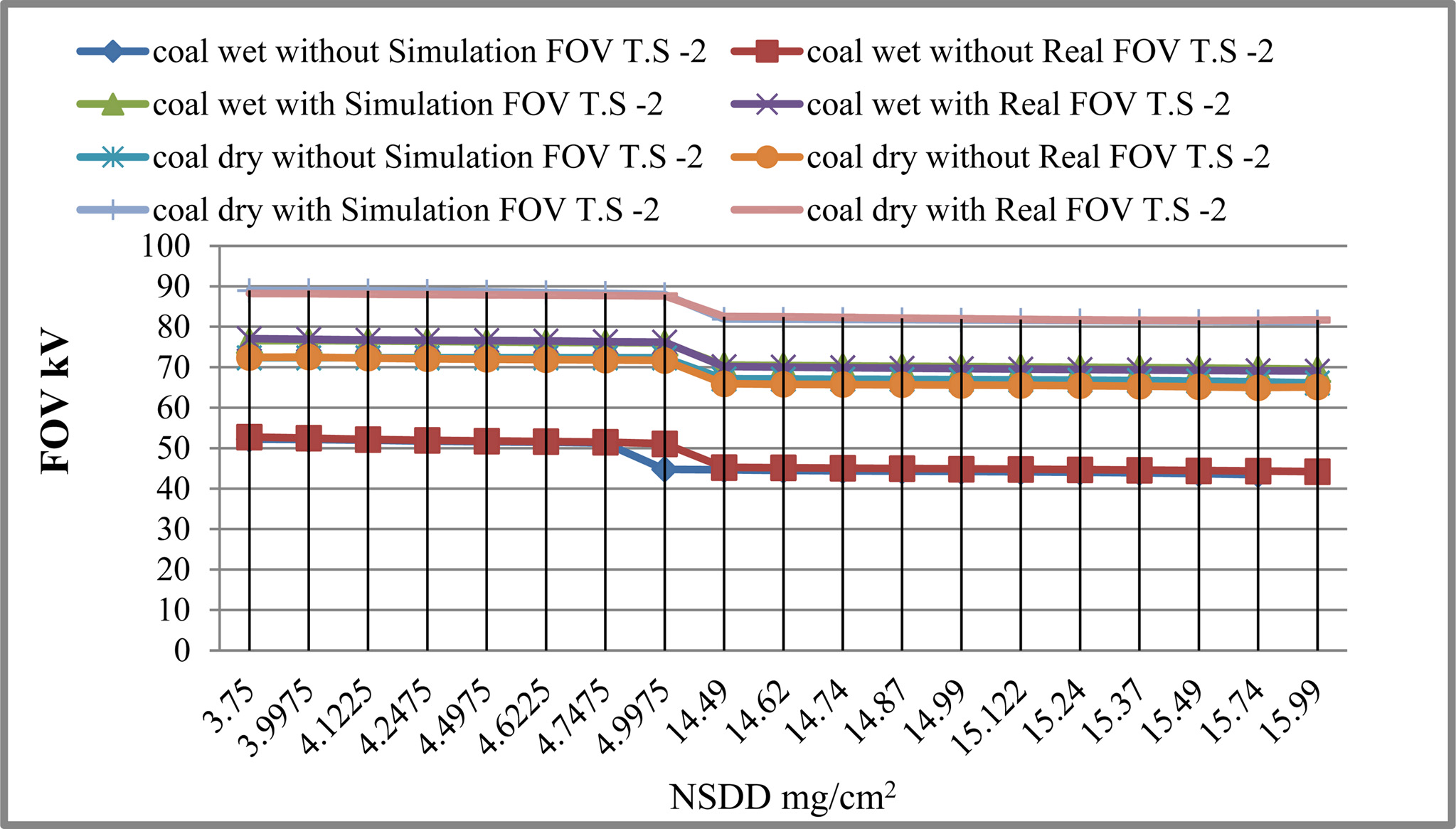
|
Fig. 7 Insulator without and with coal and RTV Coating for wet and dry conditionds under simulation and real test (experiment) on test specimen. |
The experimwntal results of the test specimen is compared
with the simulation results and the outcomes are discussed.
Simulation
result analysis using artificial neural network
In electrical power systems, to avoid insulator failure,
flashover designing is one of the major constituents. ANN is an effective tool
through MATLAB, which is used for insulator flashover. Training process of ANN require
more values which are drew out by curve fitting method of
experimental data. The TRAINLM (Leven berg-Marquardt algorithm) function is
used in Feed-forward back propagation method. The Leven berg-Marquardt (LM)
algorithm is a reiterative proficiency that locates the minimum of a function
that is evinced as the sum of squares of nonlinear occasions and is
mathematically calculated using TANSIG method [20-23].
Test
results using ANN
In this experiment, test specimens without pollutants
(coal) and RTV coating and with pollutant (coal) and RTV coating are compared
using experiment setup and ANN. In ANN, it is trained with 80 inputs and
outputs. The following comparison graph is drawn considering 19
values from initial and final of experimental data and from ANN training data
sets. In coal with wet condition and without coating result in high
experimental values when compared with ANN simulation values.
In above Fig. 8 graphical representation, coal with protective
coating under wet conditions have percentage error
values as oscillatory (both in positive and negative values). Coal without
protective coating under wet conditions have
an decreasing error percentage for starting values and increases upto 2
percentage. Coal with protective coating under dry conditions have percentage
error values as oscillatory (both in positive and negative values). But the
percentage error graph is opposite to
that in wet condition. Coal without protective coating under dry conditions have an decreasing error percentage.
Secondly, comparison of graphical representation for Fly
ash pollution under wet and dry conditions using ANN and experimental set up is
shown in Fig. 9. The graph shows that the values are same even if the
conditions are varied.
In dry condition the percentage error without coating and
flyash carried out using simulation and experimental values are oscillatory
between positive and negative values. In dry
condition the percentage error with coating and
flyash carried out using simulation and experimental values
is constant. In wet condition the percentage error without coating and flyash carried out using
simulation and experimental values
are oscillatory between positive and
negative values in the beginning and settles down at a constant negative value.
In wet condition the percentage error with coating and flyash carried out using
simulation and experimental values are negative mostly with a steep negative
surge at the end.
In Fig. 10 graphical representations for all error values are
oscillatory in positive and negative value except wet without
coating. Its function is to estimate the model relationship
between critical flashover voltage, creepage distance
and Non Soluble Deposit Density for predicting the
flashover voltage of non-soluble polluted insulator. Simulation results are
foretelling and basically logical and agree with the experimental results.
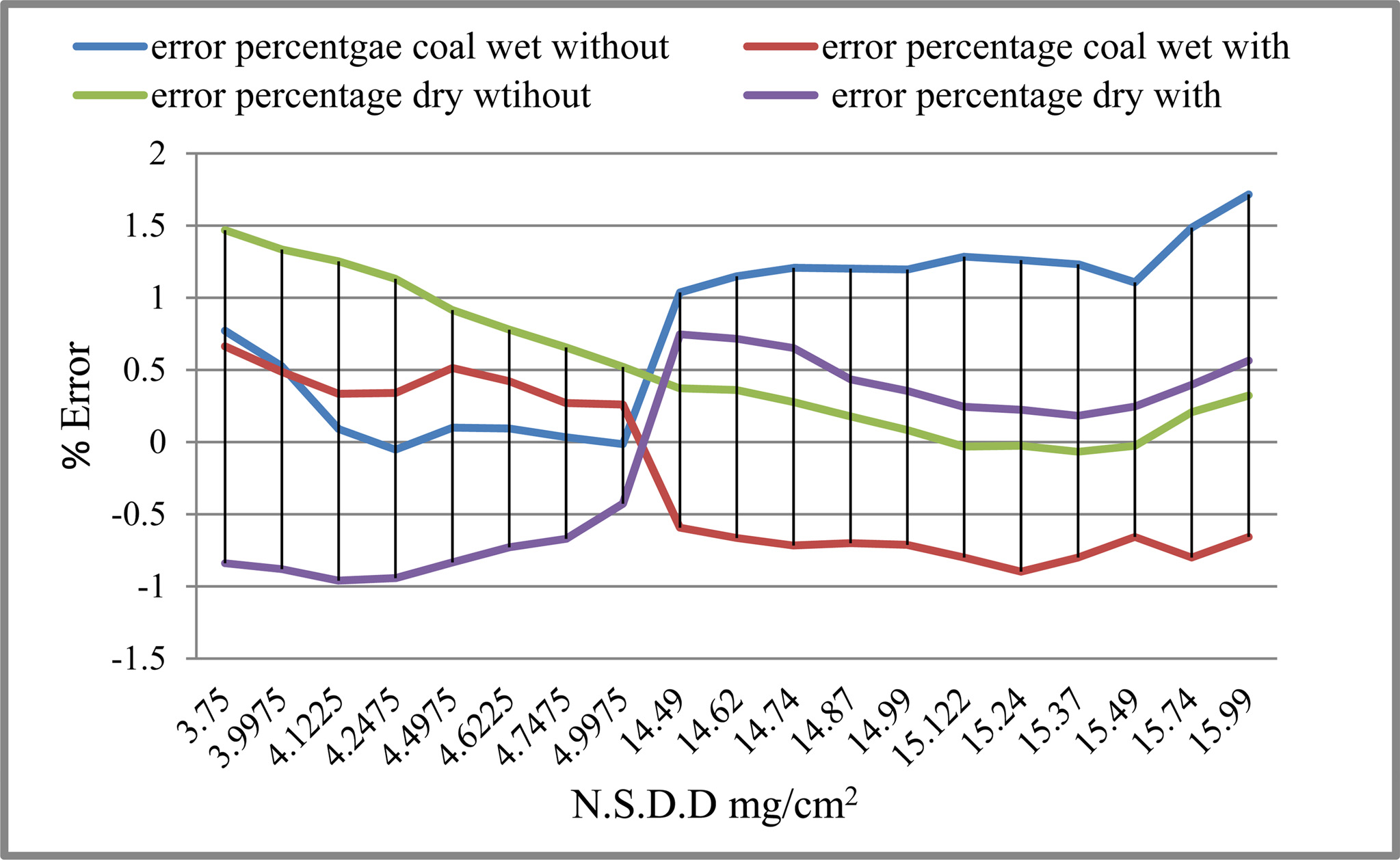
|
Fig. 8 Percentage error of test specimen with and without Coal and coating under wet and dry conditions. |
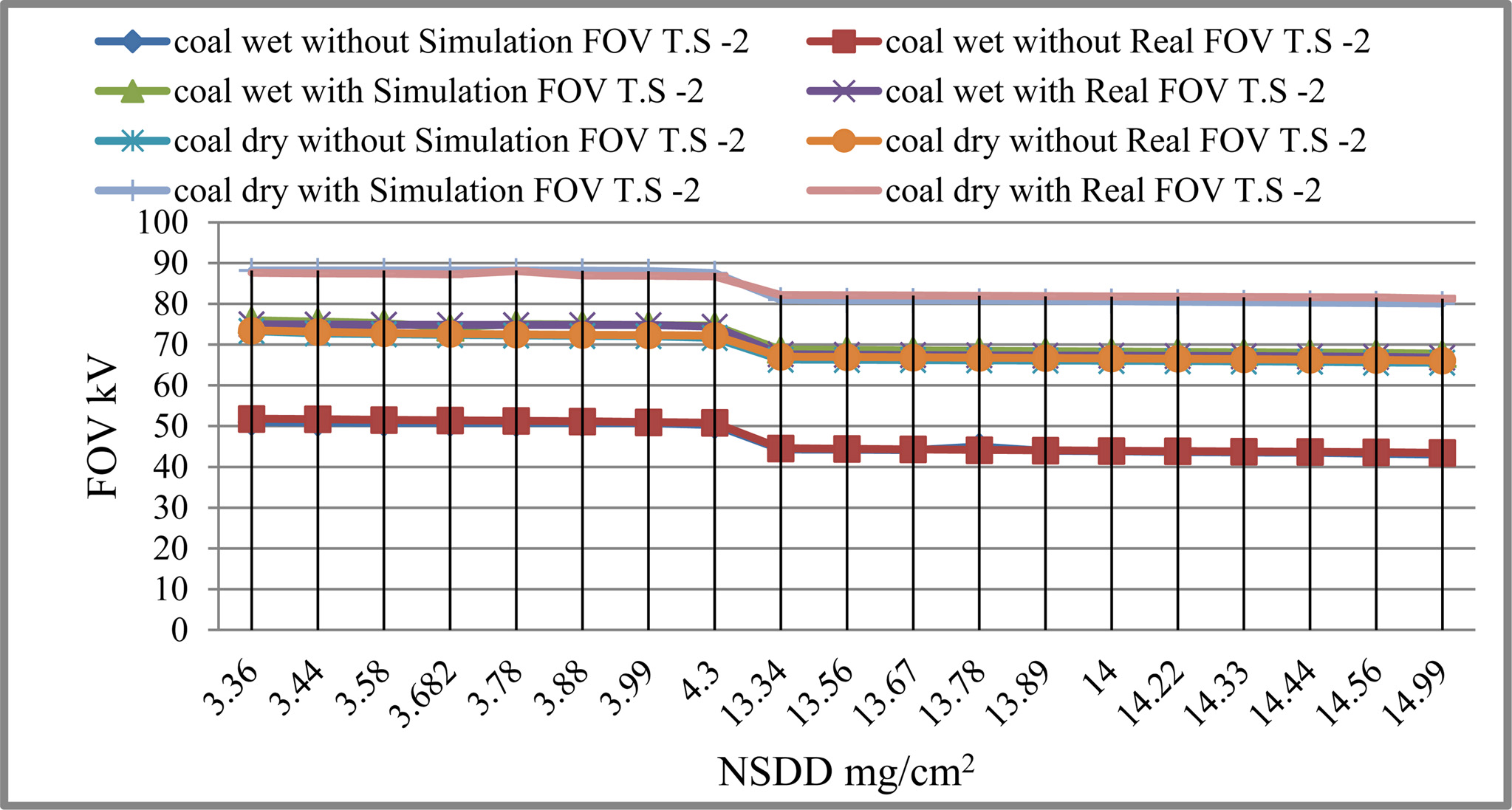
|
Fig. 9 Insulator without and with Fly ash and RTV Coating for wet and dry conditions under simulation and real value (experimental) comparison on test specimen. |
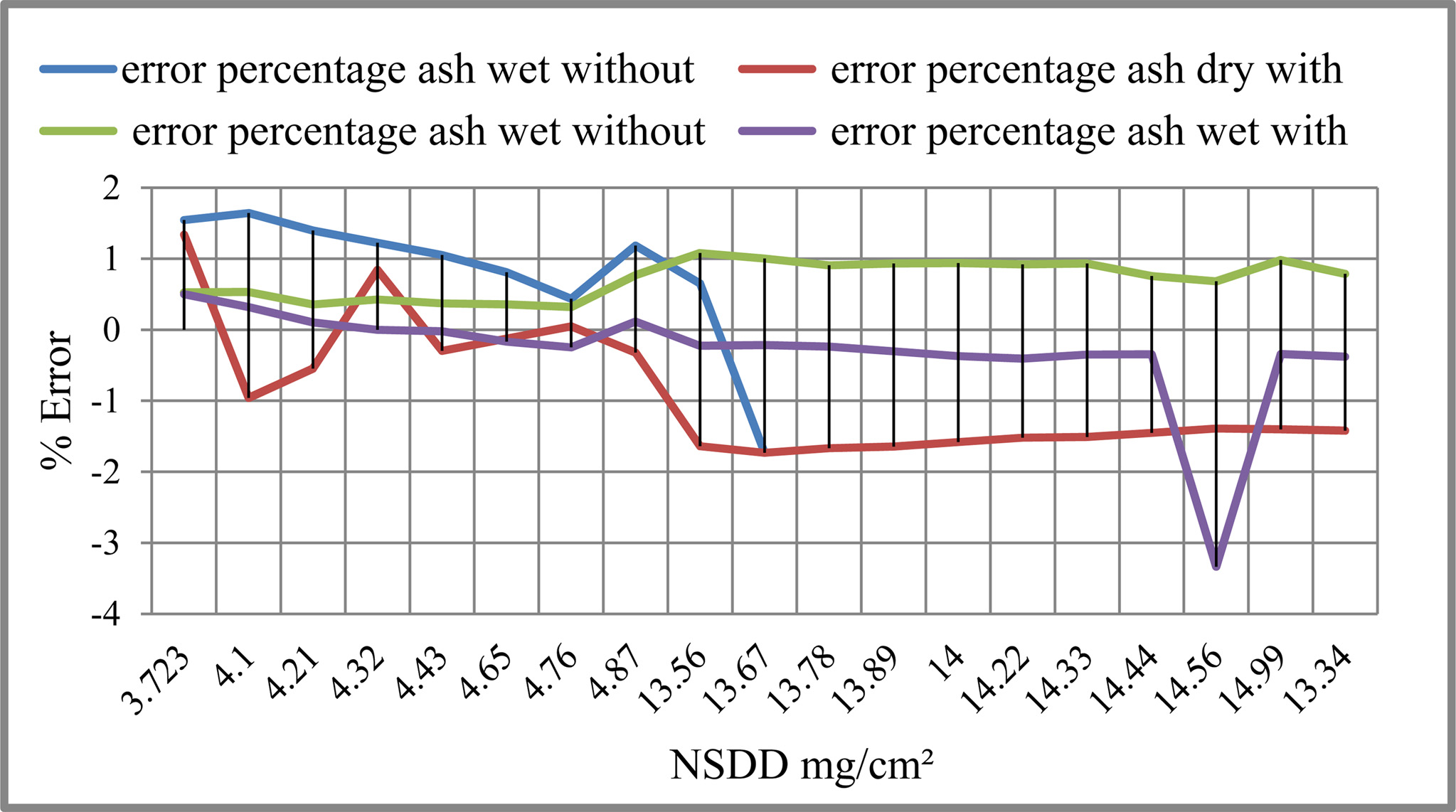
|
Fig. 10 Percentage error values for test specimen with and without Fly ash and coating under wet and dry condition. |
This paper analyses the comparison
in high voltage Post Type insulators. The artificial pollution
testing insulator flashover voltage performance is directly proportional to the
quantity of pollution severity. Non-soluble Deposit Density (NSDD) values in
coal is little higher when compared with NSDD of fly ash and combination of
coal and ash. These results indicate that Silicone
Rubber-RTV coating increases the performance of ceramic
outdoor insulator to overcome pollution effect. The coated insulator maintains
it hydrophobicity under various polluted conditions. The flashover
voltage is approximately increased up to 25% after coated with
Silicone Rubber coating. When comparing with Epoxy resin and silicone rubber
coating, RTV coated insulator has high flashover voltage at wet and dry
conditions. Silicone rubber coated insulator is suitable for seashore and
tropical climate.
Pollution performance model of investigating samples
under artificial pollution condition has been done using Artificial Neural
Network. Its function is to estimate the model relationship between
critical flashover voltage, creepage distance and Non-soluble
Deposit Density for predicting the flashover voltage of non-soluble polluted
insulator. Simulation results are promising and are basically consistent with
the experimental results.
- 1. M.G. Sugirtha, P. Latha, N. Karuppiah, and J. Shanmugapriyan, in Proceedings of the International Conference on Computing Methodologies and Communication (IEEE 2018), 926-930.
-

- 2. N. Karuppiah and V. Malathi, Technical Gazette 23[1] (2016) 221-228.
-

- 3. T. Alshaketheep, K. Murakami, and N. Sekimura, Journal of Nuclear Science and Technology, Taylor & Francis Online 53[9] (2016) 1366-1370.
-

- 4. B.S. Reddy and A.R. Verma, Applied Energy 185[2] (2017) 1724-1731.
- 5. M. Majid Hussian, S. Farokhi, S. G. Mc Meekin, and M. Farzaneh, IEEE Transactions on Dielectrics and Electrical Insulation 24[2] (2017) 1068-1076.
-

- 6. D. Pylarinos, K. Siderakis, and E. Thalassinakis, IEEE Electrical Insulation Magazine 31[2] (2015) 23-29.
-

- 7. G.K. Artun, N. Polat, O.D. Yay, Ö.Ö. Üzmez, A. Arı, G.T. Tuygun, T. Elbir, H. Altuğ, Y. Dumanoğlu, T. Döğeroğlu, A. Dawood, M. Odabasi, and E.O. Gaga, Atmospheric Environment 150 (2017) 331-345.
- 8. E.A. Cherney, M. Marzinotto, R.S. Gorur, I. Ramirez, S. Li, A. El-Hag, and A. Tzimas, IEEE Transactions on Dielectrics and Electrical Insulation 21[1] (2014) 253-261.
-

- 9. P. Balagurusamy, R.V. Maheswari, B. Vigneshwaran, and M. Willjuice Iruthayarajan, IEEE International Conference on Circuit, Power and Computing Technologies, 2014.
-

- 10. F. Gerdinand I, M. Budde I, and M. Kurrat, in Proceedings of the International Conference on Solid Dielecrics, Toulouse (2004) 320-323.
- 11. C. Chen, Z. Jia, H. Lu, Z. Yang, and T. Li, IEEE Transactions on Dielectrics and Electrical Insulation 21[6] (2014) 2458-2465.
-

- 12. B. Zegnini, D. Mahi, and A. Chaker, Acta Electrotechnica et Informatica 9[4] (2009) 17-23.
- 13. L. Wei and Y. Wu, Journal of Ceramic Processing and Research 20[3] (2019) 216-222.
- 14. Agus Edy Pramonoa, Muhammad Zaki Nuraa, Johny Wahyuadi M. Soedarsonob, and Nanik Indayaningsihc, Journal of Ceramic Processinng and Research 20[1] (2019) 1-7.
- 15. F.O. Aramide, O.D. Adepoju, and A.P. Popoola, Journal of Ceramic Processing and Research 19[6] (2018) 483-491.
- 16. Y.-D. Li, J.-M. Chen, and Y.-C. Lee, Journal of Ceramic Processing and Research 19[6] (2018) 461-466.
- 17. S. Gowthama Kannan, L. Kalaivani, M. Willjuice Iruthayarajan, and M. Bakrutheen, IEEE International Conference on Circuit, Power and Computing Technologies, ICCPCT-2014, Nagercoil, pp. 345-349.
-

- 18. S. Gowthama Kannan, L. Kalaivani, M. Willjuice Iruthayarajan, M. Bakrutheen, IEEE International Conference on Circuit, Power and Computing Technologies, ICCPCT-2014, Nagercoil, pp. 345-349.
-

- 19. W. Xiaofeng, W. Jincheng, and Z. Yi, Journal of Experimental Nanoscience 11[13] (2016) 1058-1073.
-

- 20. W. Xiaofeng, W. Jincheng, and Z. Yi, Journal of Experimental Nanoscience 11[13] (2016) 1058-1073.
-

- 21. S. Tamilselvi, N. Karuppiah, and B. Rajagopal Reddy, 1st International Conference on Sustainable Energy and Future Electric Transportation (SeFet 2019), 87, 01026, pp. 1-8.
-

- 22. S.A. Ryder, Q. He, J. Si, and D.J. Tylavsky, IEEE Transactions on Power Delivery. 16[4] (2001) pp.825-826
-

- 23. N. Karuppiah, V. Malathi, and G. Selvalakshmi, International Conference on Swarm, Evolutionary, and Memetic Computing, 8947, pp. 292-303, 2014.
 This Article
This Article
-
2020; 21(1): 14-20
Published on Feb 28, 2020
- 10.36410/jcpr.2020.21.1.14
- Received on May 15, 2019
- Revised on Oct 6, 2019
- Accepted on Oct 20, 2019
 Services
Services
Shared
 Correspondence to
Correspondence to
- M. Ravindran
-
Associate Professor (S.G), Department of EEE, National Engineering College, Tamil Nadu, India
Tel : +9194870 80584 - E-mail: ravinec99@gmail.com








 Copyright 2019 International Orgranization for Ceramic Processing. All rights reserved.
Copyright 2019 International Orgranization for Ceramic Processing. All rights reserved.